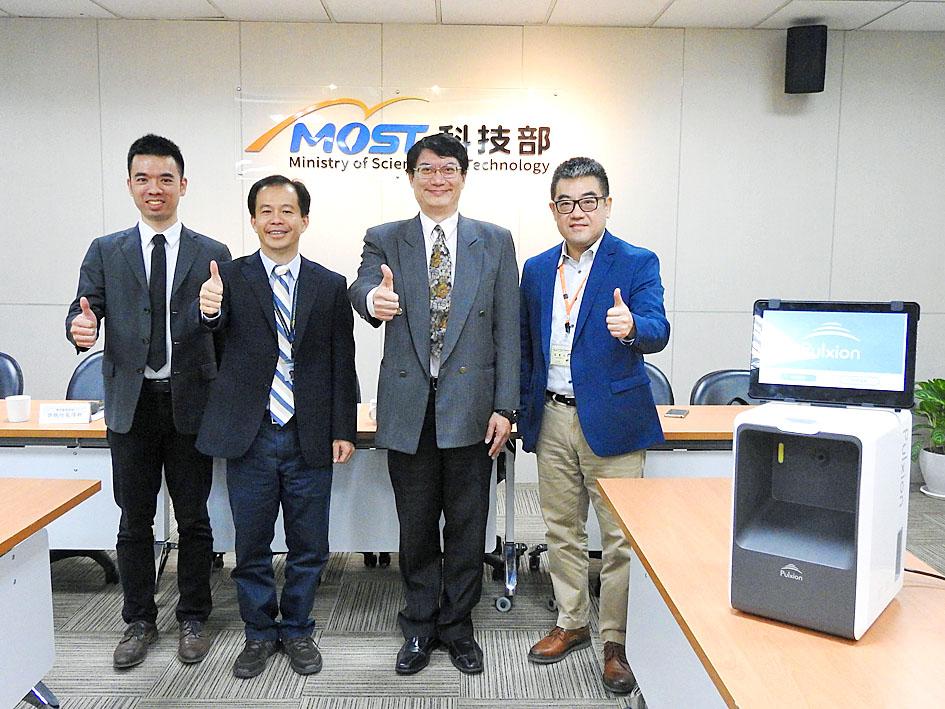A research and start-up team yesterday introduced the world’s first quick-test imaging system for stroke and cardiovascular diseases that can deliver results in five minutes.
Stroke ranks among the five top causes of death in Taiwan and the US, claiming about 12,000 and 140,000 lives each year respectively, National Taiwan University (NTU) mechanical engineering professor Hsiao Hao-ming (蕭浩明) told a news conference at the Ministry of Science and Technology in Taipei.
Hsiao said that he had worked at US Abbott Laboratories, developing medical devices from 2001 to 2009, before returning to Taiwan.

Photo courtesy of the Ministry of Science and Technology via CNA
About 85 percent of strokes are caused by ischemia, or a blockage in an artery that supplies blood to the brain, while carotid artery stenosis — a narrowing of the two major carotid arteries that carry blood from the heart to the brain — is an early indicator of stroke, he said.
Many people with cardiovascular diseases might suffer a stroke without foreseeable symptoms, so early detection is key to prevention, National Taiwan University Hospital (NTUH) cardiologist Kao Hsien-li (高憲立) said.
However, existing diagnostic tools, such as ultrasonic scanning, magnetic resonance angiography and computed tomography, are bulky, costly and need a professional operator, Hsiao said.
To facilitate early detection of strokes and cardiovascular diseases, they worked together to develop an imaging device called Pulstroke.
The device takes a 30-second video of a subject’s neck and uploads the film to a cloud server for analysis, Hsiao said.
Within five minutes, the subject can receive an assessment report on their risks of getting carotid artery stenosis and determine if they should visit a hospital for a more detailed examination, he said.
The degree of stenosis affects the dynamics of blood flow, the subtle changes of which are reflected through pulsations and can be detected by the team’s image motion analysis, he added.
The system has accumulated more than 500 clinical cases, with a precision rating of 95 percent compared with results yielded by ultrasonic scanners, he said.
The team has obtained patents for the system in Taiwan and the US, and won two National Innovation Awards in Taiwan in 2016 and last year, Hsiao said.
The system’s hardware was refined when the team received more funding from the ministry last year, he added.
While the device only needs ordinary Webcams for taking images, the team’s core technology hinges on image motion analysis, image decomposition and reconstruction, feature extraction and an artificial intelligence algorithm, he said.
In June, the team established a start-up company, Pulxion Medical Technology, with Hsiao serving as chief technology officer and Kao as chief medical officer.
The firm is awating a medical device permit from the Ministry of Health and Welfare to make it commercially available, Hsiao said.
Instead of selling the system itself, the firm plans to promote its use at pharmacies and health checkup centers, with users being charged NT$200 to NT$300 per use, only about 10 percent of the cost of self-paid checks for carotid artery stenosis at hospitals, company CEO Thomas Hsu (許沛新) said.
The company would also seek cooperation with the health ministry to promote use of the system and integrate users’ data into the database of National Health Insurance Administration, Hsiao said.
The technology could also be used to develop other tools for detecting arrhythmia, arteriovenous fistula occlusion and Parkinson’s disease, he said.

Taiwan is to commence mass production of the Tien Kung (天弓, “Sky Bow”) III, IV and V missiles by the second quarter of this year if the legislature approves the government’s NT$1.25 trillion (US$39.78 billion) special defense budget, an official said yesterday. Commenting on condition of anonymity, a defense official with knowledge of the matter said that the advanced systems are expected to provide crucial capabilities against ballistic and cruise missiles for the proposed “T-Dome,” an advanced, multi-layered air defense network. The Tien Kung III is an air defense missile with a maximum interception altitude of 35km. The Tien Kung IV and V

The disruption of 941 flights in and out of Taiwan due to China’s large-scale military exercises was no accident, but rather the result of a “quasi-blockade” used to simulate creating the air and sea routes needed for an amphibious landing, a military expert said. The disruptions occurred on Tuesday and lasted about 10 hours as China conducted live-fire drills in the Taiwan Strait. The Civil Aviation Administration (CAA) said the exercises affected 857 international flights and 84 domestic flights, affecting more than 100,000 travelers. Su Tzu-yun (蘇紫雲), a research fellow at the government-sponsored Institute for National Defense and Security Research, said the air

Trips for more than 100,000 international and domestic air travelers could be disrupted as China launches a military exercise around Taiwan today, Taiwan’s Civil Aviation Administration (CAA) said yesterday. The exercise could affect nearly 900 flights scheduled to enter the Taipei Flight Information Region (FIR) during the exercise window, it added. A notice issued by the Chinese Civil Aviation Administration showed there would be seven temporary zones around the Taiwan Strait which would be used for live-fire exercises, lasting from 8am to 6pm today. All aircraft are prohibited from entering during exercise, it says. Taipei FIR has 14 international air routes and

Taiwan lacks effective and cost-efficient armaments to intercept rockets, making the planned “T-Dome” interception system necessary, two experts said on Tuesday. The concerns were raised after China’s military fired two waves of rockets during live-fire drills around Taiwan on Tuesday, part of two-day exercises code-named “Justice Mission 2025.” The first wave involved 17 rockets launched at 9am from Pingtan in China’s Fujian Province, according to Lieutenant General Hsieh Jih-sheng (謝日升) of the Office of the Deputy Chief of the General Staff for Intelligence at the Ministry of National Defense. Those rockets landed 70 nautical miles (129.6km) northeast of Keelung without flying over Taiwan,